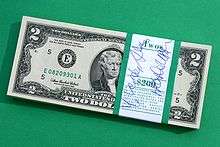Currency strap

A currency strap, also known as currency band or bill strap is a simple paper device designed to hold a specific denomination and number of banknotes. It can also refer to the bundle itself.[1]
In the United States, the American Bankers Association or ABA has a standard for both value and color, as shown below. Note that all bills greater than $1 only come in straps of 100 count. The colors allow for quick accounting, even when the bills are stacked, such as in a vault. Special striped bands are used for straps containing only star notes.
History
Bundling money together with a simple elastic or paper device is as old as paper currency itself. However, measured and standardized straps are a relatively new idea. For example, until the mid-1970s, The US Federal Reserve counted bills by hand. That is, they employed 55 currency counters whose job it was to count as well as, by touch and feel, authenticate bills.[1]
However, as the amount of currency in circulation increased, they found that they needed a more efficient way to count currency. To help the Currency Counting staff keep up, the Bank began strap-sorting the $1 to $20 notes. Straps were visually inspected and weighed against a counterweight equal to the paper mass of 100 genuine U.S. notes.
ABA Standard (United States)

| Strap Color | Bill Denomination |
Bill Count |
Total Value | |
|---|---|---|---|---|
| Black | $1 | 25 | $25 | |
| Orange | $1 | 50 | $50 | |
| Blue | $1 | 100 | $100 | |
| Green | $1 | 200 | $200 | |
| Pink | $1 | 250 | $250 | |
| Green | $2 | 100 | $200 | |
| Red | $5 | 100 | $500 | |
| Yellow | $10 | 100 | $1,000 | |
| Violet | $20 | 100 | $2,000 | |
| Brown | $50 | 100 | $5,000 | |
| Mustard | $100 | 100 | $10,000 | |